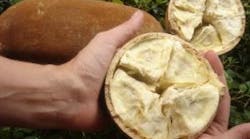The shape and nearly the size of a football, cupuaçu (Theobroma grandiflorum) fruit is a cousin of cacao and native to the South American tropical rainforests. Covered by a thick, fuzzy brown seed coat, it’s filled with a fragrant (though acidic) white pulp. Depending upon your taste preferences, it requires some preparation because of its strong flavor. Cupuaçu pulp is often puréed and used in its native South America to prepare beverages, ice cream, liquors, jellies, preserves and candy. Lately, cupuaçu beverages have trickled in to the U.S. in mixed fruit juice drinks.
With the recent rush of Amazonian “superfruits,” it’s little wonder the fruit is being tagged with such superlatives as ”the next great superfood.” Cupuaçu is loaded with a variety of flavanoid polyphenols that act as antioxidants, including catechin and epicatechin (the same as in green tea) and quercetin, the polyphenol found in grapes and berries.
Cupuaçu also is rich in other phytochemicals with tongue-twisting names, such as isoscutellarein glucuronide, isoscutellarein glucuronide 6–methyl ester, hypolaetin glucuronide, kaimpferol and various sulfated flavonoid glycosides and theograndins. That’s probably why cupuaçu has been described as a “pharmacy in a fruit.”
But the most interesting story of cupuaçu is that the seeds can be made into a remarkable chocolate analog (a product somewhat indelicately referred to in the industry as “cupulate”). Jeff Moats, president and founder of Naples, Fla.-based Equa Water Corp (www.equawater.com), and one of the pioneers behind this process, describes how the seeds left over from the pulp usage can be fermented, dried, roasted, and pressed into nubs or cakes. Those, in turn, can be used for the manufacture of the chocolate analog.
"While working with numerous sustainable development projects in the Amazon basin, we discovered cupuaçu offers more than a desirable pulp for puddings, juice and ice creams,” explains Moats. “We saw it could be a new source of ‘chocolate’ naturally low in caffeine and theobromine found in it's botanical cousin."
Except for a lighter, slightly reddish color, cupulate is nearly indistinguishable from high-quality chocolate. However, it is far lower in caffeine than chocolate. It contains quantities of thacrine (tetramethyluric acid) versus the dominant xanthines (caffeine, theobromine, and theophylline) found in cacao. Specifically, research reveals the amounts of theobromine and caffeine found in cupuaçu run “one or more orders of magnitude lower than in cacao,” according to Moats.
There still are challenges to getting cupulate to mass market. “It’s not possible to use the same process to crack the cupuaçu kernels as with cocoa because they are more resistant,” says Kevin Busby, general manager of Earthfruits USA (www.earthfruits.com), South Jordan, Utah. “The industrial production of cupulate is (still) under development.” Although Earthfruits offers mainly the ingredients made from the endocarp (the pulpy part of the fruit), specifically frozen pulp and the freeze dried powder, the company has yet to provide cupulate powder. “Freeze-drying does not affect texture of the formulated products,” Busby adds.”
Pure cupuaçu pulp (and the freeze dried pulp powder) has slightly sour taste. This lets it work well in yoghurts and cream-based applications. It also is highly suitable for hot and cold dessert formulations, as well as for hot applications such as fillings in pastry or add-ons. The freeze dried powder can be stored at room temperature. “Shelf life will be longest if kept in the vacuum, metalized bags such as come direct from our facility in Brazil,” says Busby.
How popular cupuaçu pulp will be as a dessert and beverage ingredient remains to be seen. Cupulate is another matter. Whereas logistics and legal issues may have held cupuaçu back from competing with chocolate, the real wonder of this alleged wonder food might not come until those barriers are breached. After all, confections and beverages from a healthful, low-caffeine chocolate rival would be noteworthy competitors in the lucrative marketplace.


